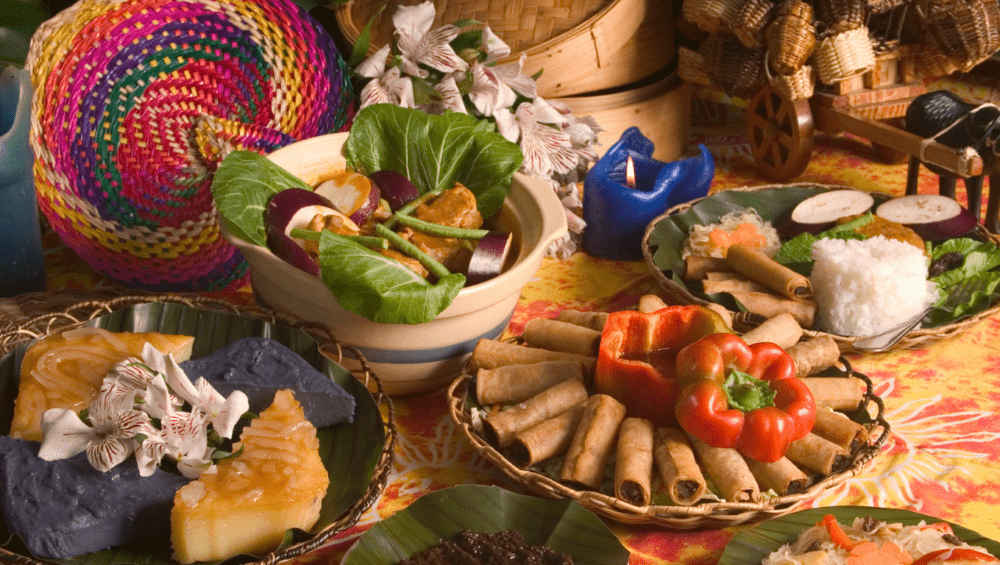Philippines Food Traditions: A Culinary Journey Through Culture and Heritage
The Philippines is a country of rich traditions, and its food culture stands as one of the most vibrant and enduring aspects of its heritage. Every bite of Filipino food is infused with history, influenced by centuries of colonization, trade, and cultural exchange. Yet, at its heart, Filipino cuisine remains deeply rooted in the country’s indigenous practices, blending local flavors with external influences to create dishes that are uniquely Filipino.
In the Philippines, food is far more than just a means of sustenance. It is an expression of identity, reflecting the country’s regional diversity and its people’s creativity. Each region boasts its own culinary specialties, shaped by geography, climate, and access to ingredients. Whether it’s the smoky bagnet of Ilocos, the fiery Bicol Express, or the delicate flavors of Visayan seafood dishes, Filipino food tells the story of a nation united by its love for bold, comforting flavors.
Food is also a medium for community and celebration. In Filipino culture, sharing a meal is an act of love and a way to strengthen relationships. Whether it’s a family gathering, a fiesta, or a simple meal among friends, food serves as the centerpiece of connection and joy. This is why traditions like kamayan, where food is shared and eaten with bare hands, hold a special place in the Filipino way of life—they emphasize the communal nature of dining and the importance of togetherness.
Perhaps most importantly, Filipino food is steeped in storytelling and meaning. Each dish carries a tale, from adobo, a recipe that has evolved over centuries, to lechon, a symbol of grand celebration. Even everyday dishes like sinigang (a sour soup) or ginataang gulay (vegetables in coconut milk) echo the resourcefulness and respect for nature that define Filipino culinary practices. Family recipes, often passed down through generations, are treasured as heirlooms, preserving the flavors and traditions of the past for future generations.
In this article, we’ll dive into the fascinating world of Philippines food traditions, exploring their origins, cultural significance, and the unique practices that make Filipino cuisine a cornerstone of the country’s identity. From festive feasts that celebrate life’s milestones to the humble yet deeply satisfying dishes that nourish daily life, this guide provides an immersive look into the Filipino way of life through its food. Whether you’re discovering these traditions for the first time or seeking to reconnect with your roots, the story of Filipino food is one of resilience, creativity, and unbreakable bonds—a true celebration of culture and heritage.
The Roots of Filipino Food Traditions
Filipino cuisine is a melting pot of influences from indigenous practices, Spanish colonization, Chinese trade, and American occupation. These influences have shaped a culinary identity that is distinctly Filipino, characterized by bold flavors, unique cooking techniques, and the ingenious use of local ingredients.
Key Influences on Filipino Food Traditions
- Indigenous Roots: Long before foreign influences, Filipino tribes relied on rice, root crops, fresh seafood, and tropical fruits. Many traditional cooking methods, such as grilling, steaming, and fermenting, date back to pre-colonial times.
- Spanish Influence: The 300-year Spanish colonization introduced ingredients like tomatoes, garlic, and onions, as well as dishes like adobo, menudo, and paella.
- Chinese Influence: Chinese traders brought noodles (pancit), spring rolls (lumpia), and soy sauce, which became staples in Filipino households.
- American Influence: During the American occupation, Filipinos adopted fast food, canned goods, and sweet flavors, seen in desserts like leche flan and halo-halo.
Iconic Filipino Food Traditions
1. Noche Buena (Christmas Eve Feast)
One of the most celebrated Filipino food traditions, Noche Buena takes place on Christmas Eve after the midnight Mass. Families gather around a lavish table filled with festive dishes such as:
- Lechon (roast pig): The centerpiece of many Filipino celebrations.
- Hamon (Christmas ham): A sweet and savory staple often paired with queso de bola (Edam cheese).
- Bibingka and Puto Bumbong: Traditional rice cakes enjoyed after Simbang Gabi (midnight Mass).
Significance: Noche Buena symbolizes love, unity, and the joy of sharing, making it a highlight of the Filipino Christmas season.
2. Kamayan (Traditional Feast)
The kamayan feast, where food is served on banana leaves and eaten with bare hands, is a uniquely Filipino tradition. It emphasizes a communal spirit and the connection between people and their food. A kamayan spread typically includes:
- Grilled meats and seafood.
- Rice served with sauces like bagoong (fermented shrimp paste).
- Tropical fruits like mangoes and bananas.
Cultural Value: Kamayan reflects Filipino hospitality and the joy of eating together without barriers.
3. Fiestas and Festivals
Philippine fiestas are grand celebrations, often held in honor of patron saints. Food plays a central role, with tables brimming with local specialties such as:
- Kare-Kare: A rich peanut-based stew with oxtail and vegetables.
- Pancit Malabon: Noodles symbolizing long life.
- Halo-Halo: A refreshing dessert of shaved ice, sweet beans, and colorful toppings.
Famous Festivals:
- Sinulog Festival (Cebu): Features lechon as a star dish.
- Pahiyas Festival (Lucban): Celebrated with colorful rice-based dishes and longganisa (local sausage).
4. Everyday Rituals: The Importance of Rice
Rice is a staple in every Filipino meal, symbolizing life and sustenance. Filipinos have a deep respect for rice, often ensuring that no grain is wasted. Popular rice-based traditions include:
- Sinangag (garlic fried rice): A breakfast favorite.
- Suman (rice cakes): Served during special occasions, often wrapped in banana leaves.
Fun Fact: Filipinos eat rice with almost every dish, whether it’s fried, steamed, or turned into a dessert.
5. Food for Religious Observances
Filipino food traditions are closely tied to religious practices:
- Lenten Season: During Holy Week, many Filipinos abstain from meat and instead eat dishes like ginataang gulay (vegetables in coconut milk) and relyenong bangus (stuffed milkfish).
- All Saints’ Day and All Souls’ Day: Families gather at cemeteries to honor departed loved ones, often bringing food like kakanin (rice cakes) to share.
6. Celebratory Meals: Birthdays and Milestones
Filipinos love celebrating milestones with food, and certain dishes are always part of the menu:
- Pancit: Believed to bring long life and good fortune.
- Spaghetti (Filipino Style): A sweet take on an Italian classic, symbolizing prosperity.
- Leche Flan: A creamy custard dessert served during special occasions.
Custom: The birthday celebrant often takes the first bite of the celebratory meal as a sign of gratitude and respect.
Regional Food Traditions in the Philippines
1. Ilocos Region
Known for its savory and tangy dishes, Ilocos food traditions include:
- Pinakbet: A vegetable dish flavored with bagoong.
- Bagnet: Crispy deep-fried pork belly.
2. Bicol Region
Famous for its spicy and coconut-based cuisine:
- Bicol Express: Pork cooked in coconut milk with chili peppers.
- Laing: Taro leaves simmered in coconut milk.
3. Visayas
A seafood haven with unique specialties:
- Kinilaw: Fresh fish marinated in vinegar and spices.
- Chicken Inasal: Grilled chicken marinated in lemongrass and calamansi.
4. Mindanao
Influenced by Islamic culture, Mindanao cuisine features bold flavors:
- Beef Rendang: A spicy, slow-cooked curry.
- Pastil: Steamed rice topped with shredded chicken, wrapped in banana leaves.
Unique Filipino Cooking Techniques
1. Adobo Cooking
Adobo, the unofficial national dish, involves marinating meat in vinegar, soy sauce, garlic, and spices before cooking it slowly. This technique preserves food while enhancing its flavor.
2. Fermentation
Traditional Filipino condiments like bagoong and patis (fish sauce) are made through fermentation, a technique passed down through generations.
3. Grilling
Grilling over charcoal is a common cooking method, especially for dishes like inihaw na baboy (grilled pork) and pusit (grilled squid).
Modern Twists on Filipino Food Traditions
As Filipinos embrace global culinary trends, traditional dishes are evolving with creative twists:
- Fusion Cuisine: Combining Filipino flavors with international techniques, like adobo pasta or ube-flavored cheesecake.
- Health-Conscious Options: Replacing traditional ingredients with healthier alternatives, such as using brown rice or lean meats.
- Street Food Revolution: Popular street foods like isaw (grilled chicken intestines) and kwek-kwek (fried quail eggs) are being reimagined in upscale dining settings.
Preserving Filipino Food Traditions
The growing interest in Filipino cuisine worldwide highlights the importance of preserving its authenticity. Efforts to document recipes, teach younger generations, and celebrate food festivals ensure these traditions remain alive.
How You Can Help Preserve Filipino Food Traditions
- Cook traditional recipes at home.
- Support local farmers and producers.
- Share Filipino food with friends and family to spread awareness of its richness.
Conclusion
Filipino food traditions are more than just culinary practices—they are a reflection of the country’s history, values, and sense of community. From festive feasts like Noche Buena to everyday rituals like kamayan, these traditions bind families and communities together, creating memories that last a lifetime.
Whether you’re a Filipino rediscovering your heritage or a food enthusiast eager to explore a new cuisine, embracing Philippines food traditions offers a journey into a culture rich in flavor, history, and heart. So grab a plate, gather your loved ones, and celebrate the Filipino way—where every meal is an opportunity to connect, share, and enjoy.



